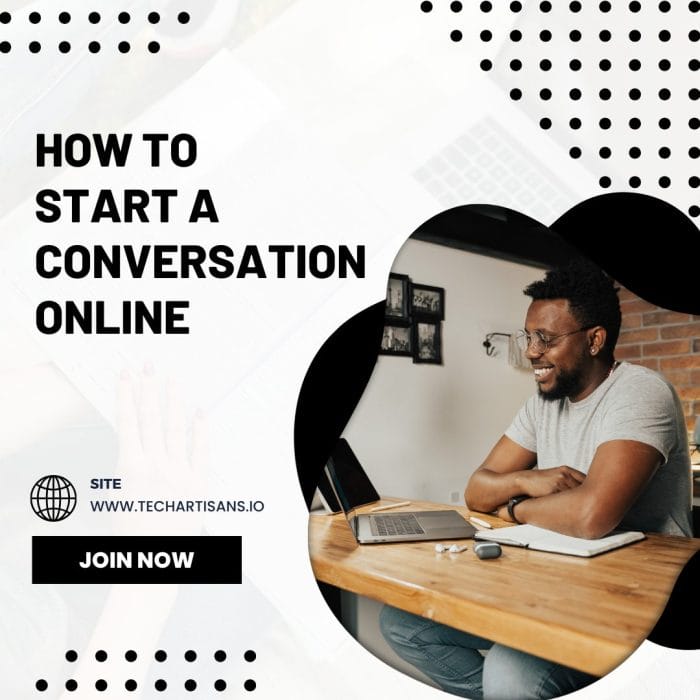In the digital era, business owners must master initiating online conversations, which are vital for breaking the ice. Online discussions now serve as the lifeblood of businesses. However, starting a conversation online remains a daunting task for many.
The challenge lies in the ice breaking and making a lasting impression that carves the path for fruitful alliances. Let’s explore some effective strategies on how to start a conversation online with potential customers and help you unlock the potential of online networking.
Read Decoding Website Conversion: Strategies for Improving Conversions
Understanding the Basics

Before we delve into tactics, let’s first understand the basics, including the ways to improve customer experience.
1. Significance of the First Message

2. Platform-based Approach Customization

Different platforms, much like different web solutions as discussed in our article on the benefits of having a website, demand varying approaches for starting a conversation with potential clients online.
a) Social Media
On social media, being casual yet professional is key. Start with something you both are interested in or comment on their recent post to initiate engagement.
b) Email
When using email, ensure your subject line is intriguing and your message concise, respectful, and relevant.
c) Forums
For forums, begin by responding to a thread related to your business field, adding value to the conversation, and gradually introducing your business or services.
Research Before You Reach Out

A key aspect, as essential as understanding lifecycle marketing, of how to start a conversation online is undertaking thorough research before reaching out. Knowledge about your potential contact, business, and interests can guide your discussion, making it more relevant and significantly increasing the probability of a positive response.
1. Recipient’s Profile

Understanding the recipient’s profile and interests allows you to tailor your message and conversation starters to their needs and preferences, ensuring they feel seen and valued. It also increases their likelihood of responding, as they are likelier to engage in a conversation that resonates with their business or personal interests.
2. Shared Interests as Conversation Starters

Shared interests, similar to connecting on professional platforms as outlined in our article on how to create a LinkedIn business page, are excellent conversation starters, forging a common ground that develops engagement and connection.
When you identify commonalities between your business and the recipient’s, it not only makes the conversation more relatable but also demonstrates your attentiveness and research. This strategy can quickly transform an impersonal online interaction into a meaningful dialogue, potentially leading to fruitful business collaborations.
Crafting the Perfect Opening Line

1. Avoid Generic Greetings

Generic greetings like “Hi” or “Hello” are often overlooked in online messages. They lack personalization and fail to capture the recipient’s attention. To stand out, personalize the greeting by including the recipient’s name and, if appropriate, a brief, relevant comment about their work or interests.
2. Asking Open-ended Questions

Asking open-ended questions encourages a more detailed response, promoting deeper engagement. For example, instead of asking, “Do you like digital marketing?” an open-ended question would be, “What do you find most challenging about digital marketing?”. This invites the other party to share their insights and experiences and opens up pathways for further discussion.
3. Sharing a Genuine Compliment

Sharing a genuine compliment can be an effective conversation starter that promotes goodwill and openness. It could be about their work, a recent achievement, or something you admire about their business. However, ensure your compliment is specific, sincere, and relevant, as authenticity is key to building a meaningful online conversation.
4. Using Humor Wisely

Maintaining the Conversation

Maintaining a conversation online is just as important as initiating one. It involves engaging actively, listening intently, and responding thoughtfully.
1. Active Listening

Active listening is key in maintaining an online conversation. It involves not just hearing but understanding and responding to the other person’s insights. Show genuine interest by asking follow-up questions or commenting on their shared experiences. Meaningful conversations are always a two-way street.
2. Asking Follow-up Questions

Asking follow-up questions is an effective way to keep the conversation going and show your genuine interest. These questions help delve deeper into the topic, providing a clearer understanding of the other party’s perspective. For instance, if they mention a recent project, you could ask, “What were some challenges you faced during that project?”. This not only keeps the conversation engaging but also demonstrates your interest in their experiences.
3. Sharing Relevant Content or Resources

Sharing relevant content or resources can also sustain an online conversation. If you encounter an article, blog post, or study that aligns with your discussion, don’t hesitate to share it with your counterpart. This enriches the conversation and positions you as a valuable source of information, further strengthening your business relationship.
Engage with Authenticity

Promoting authenticity in online conversations, a principle also vital in how to connect with customers through your website is paramount in building trust and lasting connections. A genuine approach can significantly enhance the quality of your interactions, making them more meaningful and impactful.
1. Being Genuine in Your Approach

Being genuine in your approach is about showing your true self and expressing your thoughts and ideas honestly. It’s about removing the sales pitch from your initial conversations and focusing on building rapport and understanding. This sincerity can help to differentiate you from the crowd, making your conversations memorable and your business relationships durable.
2. Avoiding Overly Promotional Language

Excessive promotion can often be a conversation killer when initiating online dialogue. It’s crucial to remember that your aim is to foster a meaningful connection, not to push for a sale. Promoting your business excessively can make the interaction transactional, which may deter the recipient from engaging further. Instead, strive for a balanced conversation that focuses on mutual interests, shared knowledge, and establishing rapport.
3. Sharing Personal Experiences and Stories

Sharing personal experiences and stories is a powerful way to humanize online conversations. Sharing struggles, successes, or interesting tales from your business journey can be a great conversation starter.
Ensure your stories are relevant and reflect your brand’s authenticity. This approach not only enhances the other party’s understanding of your business but also sparks their interest, encouraging them to share their own experiences.
Visual Content

Visual content, similar to the top benefits of using videos on a website, is an innovative strategy to captivate your audience’s attention in online conversations. Employing rich, illustrative media such as infographics, images, or videos can add depth to your dialogue, making your communication more engaging and memorable.
1. Using GIFs, Memes, and Videos

Utilizing GIFs, memes, and videos can significantly enhance engagement in your online conversations. These visual mediums offer a fun and interactive way to express thoughts and emotions, making the conversation more lively and relatable. Ensure the visual content aligns with your brand’s voice and is appropriate for the conversation.
2. Importance of Visual Storytelling

Visual storytelling is crucial in online conversations as it builds an emotional connection, relatability, and comprehension. It enables you to convey complex ideas in a digestible, engaging manner. You can capture your audience’s attention through compelling visuals and narratives, enhance message retention, and stimulate action.
Overcoming Common Challenges

Let’s explore some common obstacles and practical strategies on how to overcome them, ensuring your online conversations are both engaging and effective.
1. Dealing With No Responses

Not receiving a response to your initial outreach can be discouraging. However, many face an obstacle when trying to start a conversation online. There are a few strategies to address this.
- First, be patient. Remember, people are busy and may need time to respond.
- Second, review your message. Ensure it’s concise, relevant, and personalized. A generic request is more likely to be ignored.
- Lastly, consider a gentle follow-up. A polite reminder can bring your message back to their attention.
2. Handling Negative Feedback

Managing negative feedback or criticism can be challenging but is crucial for maintaining productive conversations online. Treat every criticism as an opportunity for growth, regardless of its tone. Avoid responding defensively; instead, demonstrate understanding and express gratitude for the feedback. Acknowledge their concerns, apologize if necessary, and communicate any steps taken towards resolution.
3. Navigating Cultural Differences

Navigating cultural differences is vital in online conversations, particularly with international partners. Awareness of and respecting different cultural norms, perspectives, and communication styles can help avoid misunderstandings and strengthen business relationships. It’s about embracing diversity and promoting a mutually respectful dialogue.
Safety and Privacy Considerations

Safety and privacy are paramount when navigating online conversations, particularly in a business context.
1. Avoid Oversharing Personal Information

Avoiding oversharing personal information is vital when engaging in online conversations. It’s important to balance being open and maintaining your privacy. Be careful about revealing sensitive business or personal information since, once shared; it’s virtually impossible to take back. This is particularly pertinent in public forums or social media platforms. Always know the platform’s privacy settings and who can access your conversations.
2. Respecting Boundaries and Privacy Settings

Respecting boundaries and privacy settings is a crucial aspect of online conversations. Always honor the privacy settings established by your conversation partners. Do not share or access information beyond permitted, maintaining professionalism and fostering trust. Understanding and respecting digital boundaries is central to ethical and successful online communication.
Conclusion
Mastering “how to start a conversation online,” akin to understanding what makes for a badass website, can open doors to numerous opportunities and relationships.
Key steps include acknowledging and overcoming common challenges, using visual content for engaging discussions, and prioritizing safety and privacy. To develop an ability to start a conversation, you must be patient, accept criticism positively, and celebrate cultural diversity. Enhance engagement with GIFs, memes, videos, and visual storytelling while being cautious about oversharing personal information.







